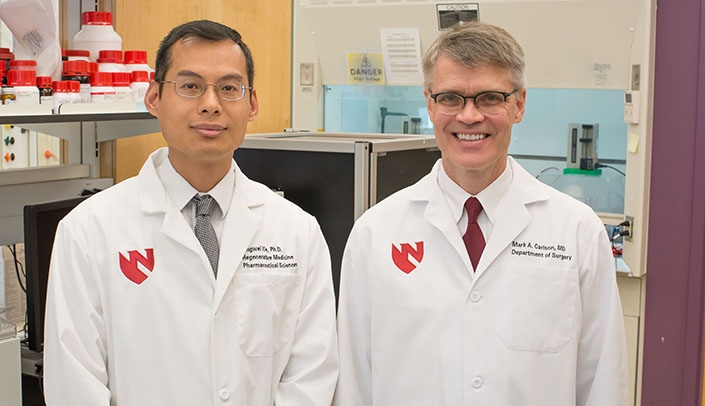At the site of a rural car crash or on a military battlefield, first responders can have trouble stopping severe bleeding from what is called a junctional injury. That is, where an extremity meets the torso.
The wound is too far inside to reach.
“It’s difficult to treat in the field because you can’t apply direct pressure,” said Mark Carlson, M.D., professor of surgery. The patient is in real danger of bleeding to death.
“We need to stabilize them, keep the patient alive long enough to make it through the transport phase,” Dr. Carlson said. “If the first responders can get the injured patient to a hospital alive, odds are, the patient will survive.”
And so, Dr. Carlson, a surgeon-scientist, who has a dual appointment at UNMC and the VA Nebraska Western-Iowa Health Care System, is working again with his frequent partner and collaborator, Jingwei Xie, Ph.D.
Dr. Xie is a biomedical engineer in the UNMC Department of Surgery and Holland Regenerative Medicine Program. The two like to team up to bring engineering solutions to surgical problems.
They had an idea: a synthetic foam that would expand in the wounded cavity, stopping the leak, absorbing blood and applying pressure — to encourage clotting.
“It’s a solid material, but it’s injectable,” Dr. Xie said. “We would pack it in a syringe.”
Think foam packing peanuts, Dr. Carlson said.
Or for a crude, but lay-friendly comparison, it’s a similar concept to DIY crack-filling spray foam insulation, or Fix a Flat temporary tire repair.
But, “It’s biocompatible, the body would absorb it,” Dr. Carlson said.
The raw material is a previously FDA-approved material. Dr. Xie and his lab are working on reformulating different nanostructures, in order to tweak its effectiveness.
The idea is already receiving rave reviews. Drs. Carlson and Xie have worked with UNeMed, UNMC’s technology transfer company, and the invention has been licensed to a biomedical company that specializes in bleeding control.
And their work is being funded by a three year, $2.2 million grant from the U.S. Department of Defense, which sees the potential to save the lives of U.S. service members.
“There may be many, many crossover applications in the clinical realm,” Dr. Carlson said.
For now, they are collecting data using pre-clinical pig models. They hope to leverage these findings into asking the FDA for an investigational device exemption (IDE) for human clinical trials.

Way to go!
Congratulations and great work!
Great work! Thank you for working to save lives!
Congratulations on moving these great ideas forward to improve outcomes. Very exciting.
Amazing! This will no doubt save many lives.
Congratulations on the DoD grant!
Congratulations!!
Very proud of you brother!!!